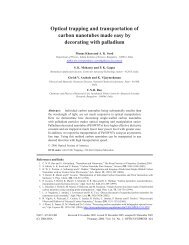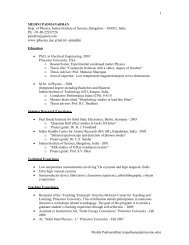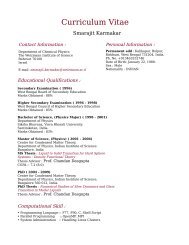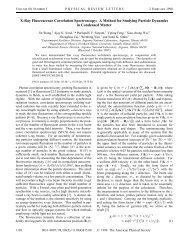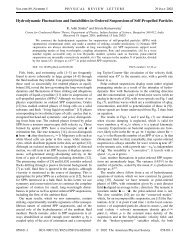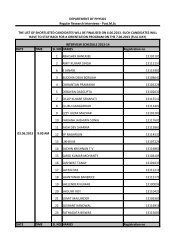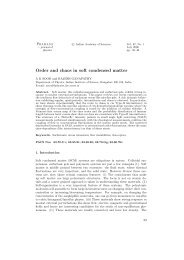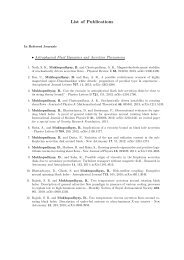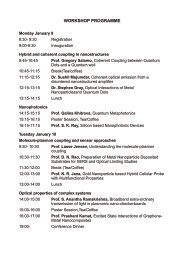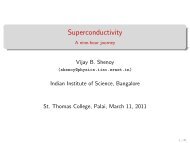C. Usha Devi, R. S. Bharat Chandran, R. M. Vasu and A.K. ... - Physics
C. Usha Devi, R. S. Bharat Chandran, R. M. Vasu and A.K. ... - Physics
C. Usha Devi, R. S. Bharat Chandran, R. M. Vasu and A.K. ... - Physics
You also want an ePaper? Increase the reach of your titles
YUMPU automatically turns print PDFs into web optimized ePapers that Google loves.
<strong>Devi</strong> et al.: Mechanical property assessment of tissue-mimicking phantoms…<br />
ing independent of its scattering coefficient. This need not be<br />
true in practical situations where malignancy presents increased<br />
stiffness <strong>and</strong> absorption coefficient <strong>and</strong> not a large<br />
variation in scattering coefficient. Curve A of Fig. 5 compares<br />
the experimental variation of g 2 modulation with stiffness<br />
with theoretical simulation data, wherein s varies with stiffness<br />
similar to that seen in the phantom. The experimental<br />
variation fits very well with the corresponding theoretical<br />
variation in curve A. Curves B <strong>and</strong> C are variations of the<br />
simulated g 2 modulation depth with storage modulus, with<br />
the s used as a parameter. These do not quite agree with the<br />
experimental measurements. These curves tell us that the scattering<br />
coefficient variation does contribute to the modulation<br />
depth in g 2 but by a very small amount.<br />
7 Conclusion<br />
The present work is aimed at pushing the case for a quantitative<br />
reconstruction from ultrasound assisted optical elastography<br />
UAOE. 15 In UAOE, the read-out is the modulation in<br />
g 2 , which originates from the optical path length modulation<br />
created by the US beam in the focal region. Since storage<br />
modulus is to be recovered from the amplitude of vibration<br />
induced by the US force, it is important for the quantitative<br />
recovery of storage modulus to separate the contribution of<br />
n to the modulation in g 2 . In the present work it is shown<br />
that the displacement induced by the US force in the focal<br />
region is along the axis of the transducer, <strong>and</strong> the fluctuations<br />
in refractive index are not direction dependent. We show here<br />
that the modulation in g 2 read-out from the light propagation<br />
perpendicular to the US transducer axis is not significantly<br />
affected by the storage modulus variation, whereas for<br />
axial light propagation, the storage modulus variation has a<br />
significant effect on the read-out. The modulation depth decreases<br />
<strong>and</strong> converges to a constant value as the storage<br />
modulus increases beyond a certain value. This constant<br />
modulation depth is the contribution of only refractive index<br />
fluctuation, <strong>and</strong> was the same for both axial <strong>and</strong> transverse<br />
photon interrogation. From this it is possible to quantify <strong>and</strong><br />
remove the contribution to the measured g 2 modulation<br />
from the refractive index fluctuations. In addition, we have<br />
found that the a contrast, as read-out from the g 2 modulation<br />
depth of axially directed photons, is severely affected<br />
by an increase in storage modulus. But for transverse directed<br />
photons, the a contrast is not seriously affected by an increase<br />
in storage modulus <strong>and</strong> therefore, for the reconstruction<br />
of absorption coefficient in UAOT, the light should be<br />
launched perpendicular to the focusing US transducer axis.<br />
Finally, it is also seen that contribution to the modulation<br />
depth through s variation is not very significant.<br />
Acknowledgment<br />
The authors wish to thank one of the reviewers who suggested<br />
redoing the simulations, which helped them to underst<strong>and</strong> the<br />
data in Fig. 3 more accurately. The authors are grateful to T.<br />
Kamakura for very kindly helping them with the programs for<br />
solving the Westervelt’s equation. R. Padmaram provided invaluable<br />
assistance during the experiments.<br />
References<br />
1. M. J Schmitt, “OCT elastography: imaging microscopic deformation<br />
<strong>and</strong> strain of tissue,” Opt. Express 3, 119–211 1999.<br />
2. S. J. Kirkpatrick, “Optical elastography,” Proc. SPIE 4241, 58–68<br />
2001.<br />
3. J. C. Hebden, S. R. Arridge, <strong>and</strong> D. T. Delpy, “Optical imaging in<br />
medicine: I . Experimental techniques,” Phys. Med. Biol. 42,<br />
825–840 1997.<br />
4. A. P. Gibson, J. C. Hebden, <strong>and</strong> S. R. Arridge, “Recent advances in<br />
diffuse optical imaging,” Phys. Med. Biol. 50, R1–R43 2005.<br />
5. H. Dehgani, B. W. Pogue, S. P. Poplak, <strong>and</strong> K. D. Paulsen, “Multiwavelength<br />
three-dimensional near-infrared tomography of breast:<br />
initial simulation, phantom <strong>and</strong> clinical results,” Appl. Opt. 42, 135–<br />
145 2003.<br />
6. A. H. Hielscher, A. Y. Bluestone, G. S. Abdoulaev, A. D. Klose, J.<br />
Lasker, M. Stewart, U. Netz, <strong>and</strong> J. Beuthan, “Near-infrared diffuse<br />
optical tomography,” Dis. Markers 18, 313–337 2002.<br />
7. T. G. Mason, H. Gang, <strong>and</strong> D. A. Weitz, “Diffusing-wave spectroscopy<br />
measurements of visco-elasticity of complex fluids,”<br />
J. Opt. Soc. Am. A 141, 139–149 1997.<br />
8. F. Ziemann, J. Radler, <strong>and</strong> E. Sackmann, “Local measurements of<br />
viscoelastic moduli of entangled actin networks using an oscillating<br />
magnetic bead micro-rheometer,” Biophys. J. 66, 2210–2216 1994.<br />
9. A. R. Bausch, W. Moller, <strong>and</strong> E. Sackmann, “Measurement of local<br />
visco-elasticity <strong>and</strong> forces in living cells by magnetic tweezers,”<br />
Biophys. J. 76, 573–579 1999.<br />
10. R. M. Simmons, J. T. Finer, S. Chu, <strong>and</strong> J. A. Spudich, “Quantitative<br />
measurements of force <strong>and</strong> displacement using an optical trap,”<br />
Biophys. J. 70, 1813–1822 1996.<br />
11. W. Leutz <strong>and</strong> G. Maret, “Ultrasonic modulation of multiply scattered<br />
light,” Physica B 204, 14–19 1995.<br />
12. L. V. Wang <strong>and</strong> X. Zhao, “Ultrasound modulated optical tomography<br />
of absorbing objects buried in dense tissue—simulating turbid<br />
media,” Appl. Opt. 36, 7277–7282 1997.<br />
13. M. Kempe, M. Larionov, D. Zaslarsky, <strong>and</strong> A. Z. Genack, “Acoustooptic<br />
tomography with multiple scattered light,” J. Opt. Soc. Am. A<br />
14, 1151–1158 1997.<br />
14. S. Leveque, A. C. Boccara, M. Lebec, <strong>and</strong> H. S. Jalmes, “Ultrasonic<br />
tagging of photon paths in scattering media: parallel speckle modulation<br />
processing,” Opt. Lett. 3, 181–183 1999.<br />
15. C. <strong>Usha</strong> <strong>Devi</strong>, R. M. <strong>Vasu</strong>, <strong>and</strong> A. K. Sood, “Application of<br />
ultrasound-tagged photons for measurement of amplitude of vibration<br />
of tissue caused by ultrasound: theory, simulation <strong>and</strong> experiments,”<br />
J. Biomed. Opt. 113, 034019 2006.<br />
16. T. A. Krouskop, T. M. Wheeler, F. Kallel, B. S. Garra, <strong>and</strong> T. Hall,<br />
“Elastic moduli of breast <strong>and</strong> prostate tissues under compression,”<br />
Ultrason. Imaging 20, 260–274 1998.<br />
17. D. A. Weitz <strong>and</strong> D. J. Pine, “Diffusing wave spectroscopy,”<br />
in Dynamic Light Scattering: The Method <strong>and</strong> Some Applications, W.<br />
Brown, Ed., Oxford University Press, Oxford, UK 1993.<br />
18. T. Kamakura, T. Ishiwata, <strong>and</strong> K. Matsuda, “Model equation for<br />
strongly focused finite-amplitude sound beams,” J. Acoust. Soc. Am.<br />
107, 3035–3046 2000.<br />
19. F. A. Duck, “Nonlinear acoustics in diagnostic ultrasound,”<br />
Ultrasound Med. Biol. 281, 1–182002.<br />
20. K. R. Nightingale, M. L. Palmeri, R. W. Nightingale, <strong>and</strong> G. E.<br />
Trahey, “On the feasibility of remote palpation using acoustic radiation<br />
force,” J. Acoust. Soc. Am. 110, 625–634 2001.<br />
21. D. Fu, S. F. Levinson, S. M. Gracewskig, <strong>and</strong> K. J. Parker,<br />
“Non-invasive quantitative reconstruction of tissue elasticity using an<br />
iterative forward approach,” Phys. Med. Biol. 45, 1495–1509 2000.<br />
22. S. Sakadzic <strong>and</strong> L. V. Wang, “Ultrasonic modulation of multiply scattered<br />
coherent light: An analytical model for aniostropically scattering<br />
media,” Phys. Rev. E 66, 026603 1–9 2002.<br />
23. S. E. Skipetrov <strong>and</strong> I. V. Meglinski, “Diffusing-wave spectroscopy in<br />
r<strong>and</strong>omly inhomogeneous media with spatially localized scatterer<br />
flows,” J. Exp. Theor. Phys. 864, 661–665 1998.<br />
Journal of Biomedical Optics 024028-9<br />
March/April 2007 Vol. 122



